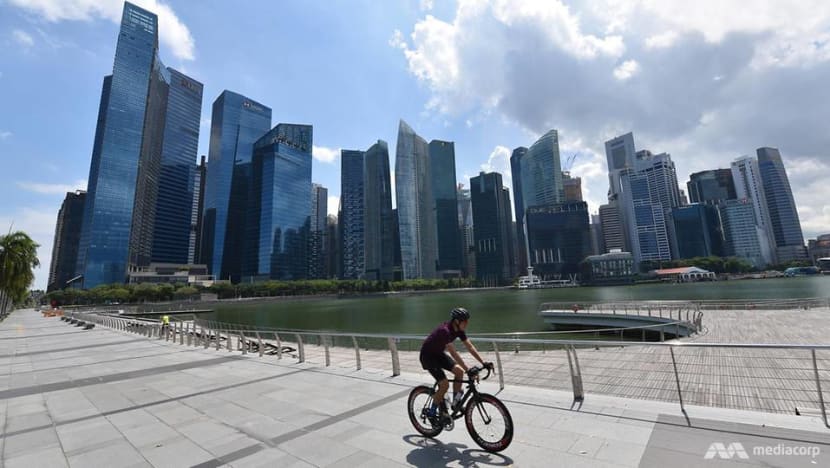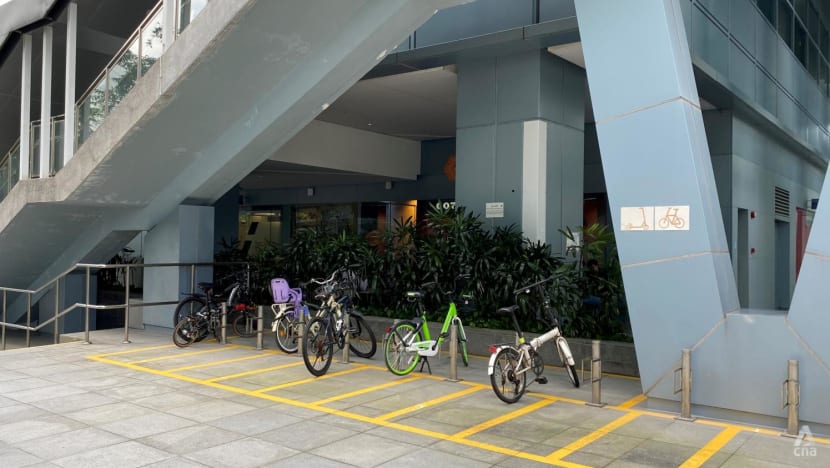Want to start cycling to work? 6 basic tips every amateur cyclist needs to know
Singapore’s Walk Cycle Ride vision aims to create a car-lite city, but just how feasible is cycling as a mode of transport? CNA's Grace Yeoh and two avid cyclists share what to expect if you plan to start.

A cyclist rides along the Marina Bay Waterfront Promenade during Singapore's "circuit breaker" period. (File photo: CNA/Jeremy Long)
SINGAPORE: In March, the Land Transport Authority announced a “Friendly Streets” initiative that aims to transform neighbourhoods into more pleasant spaces for pedestrians and cyclists.
This initiative, together with an increase in cycling paths over the past few years, convinced me to attempt to cycle to work – a feat I've always wanted to try, despite being an amateur cyclist who doesn't even own a bike.
Forget recommendations for bicycles or backpacks. Here are the most basic must-knows – with added advice from more seasoned cyclists who cycle to work regularly – to help anyone mentally prepare for the ride.
1. FAMILIARISE YOURSELF WITH YOUR ROUTE – IN PERSON
Whether you plan to use the park connectors, pavements or roads, never rely solely on navigation apps to do a recce. You might get a rough gauge of the time it would take, but apps don’t take into account the unpredictability of human traffic.
My route took me past school zones and MRT stations, which meant I would need to slow down for pedestrians and be more alert if I was on walking paths during peak periods.
Mrs Jhoi Tan, who has been cycling to work over the last year since she started returning to the office on a more regular basis, used to notice several cyclists along the same route as her bus.
That was when the 45-year-old, who is part of local cycling Facebook group West Coast Riders, realised cycling to work was possible. She initially rented a bicycle from a bike-sharing app to try out her route on a weekend.
“I wanted to try how long it would take me, if there are a lot of potholes or if there is heavy pedestrian traffic. You will also know which side of the road to ride that will be more time-efficient,” she said.
It's also normal to be nervous when one first starts cycling to work. I, for one, hemmed and hawed for two days before embarking on my first ride.
But rather than cycle to work, I chose to start by cycling back home from work instead. The return trip removes the pressure of getting to the office on time, while familiarising yourself with the same route on a weekday.
2. STICK TO PARK CONNECTORS AND PAVEMENTS WHERE POSSIBLE
You may encounter an irate pedestrian or two, but better a vulgarity than an obituary about you.
While it might take a longer time to arrive at your destination by sticking strictly to park connectors and pavements, it is not entirely impossible depending on your home and office locations.
Mrs Tan, who lives in Bukit Panjang, cycled to her office at Toh Tuck in Jurong East via the park connector network (PCN). This took her through Hillview, Upper Bukit Timah and Bukit Batok.
“When I cycle, I go by PCN and sidewalks. I don’t go on the roads. I don’t dare to go with the cars and buses. It’s very bike-friendly with the PCN,” she explained.
Alternatively, opt for public transport and use a rental bike as first- and last-mile transport.
3. CONFIDENCE IS KEY TO ROAD CYCLING
Nonetheless, should you decide to ride on the road, “you need to have confidence”, noted 60-year-old Mahmoud Alavi, who picked up cycling in 2012 after spinal surgery.
The avid road cyclist has been cycling from his home in Lakeside at Jurong East to his workplace in Tanglin near Orchard Road for four years.
“If a rider rides too slow, it’s a hazard to the rest of the road users. Usually, for my route, my speed is about 35kmh, which is not that slow,” he said, pointing out that he rides near to the bus lane.
As such, if one has “a phobia of getting near to the car”, the road is “not a place for your ride”, he advised. “I do come across many times that a car comes near me. If you don’t have the confidence or ability to control your bicycle, a person will (fumble).”
Being alert is also crucial for road cyclists, especially if one hits a pothole while travelling at 30 to 35kmh, added Mr Alavi, who is also part of West Coast Riders.
“You may definitely lose balance. If you’re not alert enough to take a look at whether you can navigate around it, you may end up in a ditch.”

4. ADD EXTRA “BUFFER TIME” IF YOU’RE BIKE-SHARING
Like Mrs Tan, who first did a recce of her route with a rental bike, bike-sharing allows you to test the feasibility of cycling to work before investing in a bike of your own.
But my experience with bike-sharing was hit-or-miss – not every bike came with a basket, working brakes and bell, or a seat that could be adjusted. Be prepared to walk to the next nearest parking spot to hunt down a fully functioning bike.
“You need to put safety first. If not for you, then for the pedestrians,” said Mrs Tan, who has since bought her own Brompton bike.
Before setting off, make sure you have also located a legal parking spot near your office. You may need to factor in the time taken to walk from the nearest parking spot.
5. MAKE YOURSELF SEEN AND HEARD – EVEN DURING THE DAY
Once you embark on your journey, you should be seen and heard easily by pedestrians and motorists.
If you usually tote around a laptop, consider a waterproof cycling backpack with a laptop compartment – and get it in a striking palette.
Wear bright-coloured shirts too, or invest in a few solely for cycling if you prefer to keep your outfit muted at work.
“This can be especially (useful) when it gets dark, like when you’re staying late in the office,” advised Mrs Tan. But “even in the daytime”, you have to make yourself seen when you’re on the road.
This, in addition to a bell, will make you more visible on relatively crowded park connectors in the morning.
“There's a lot of people, especially in the morning, jogging or walking and they have their (earphones). Sometimes, they think we’re going fast, but it’s just because they couldn’t hear the bell," she said.
"Even if you ring the bell, they just won’t stay on their right. They will just stay in the middle of the (pavement)."
But Mrs Tan also acknowledged that, as she doesn’t cycle on the main roads, she just has to be more patient with such pedestrians and to always give way.
Mr Alavi, on the other hand, doesn't believe it's necessary to wear bright-coloured clothes as his bike has two rear blinkers and a front blinker.
He also relies on the "illuminated strips" behind his bicycle fork – the part of a bicycle that holds the front wheel – to alert drivers behind him when they reflect light at night.
6. FORGO FASHION, CHOOSE COMFORT
It's not Tour de France, so skin-tight cycling attire isn't de rigueur. But one thing's for sure: Ditch the dresses. Even with safety shorts, cycling in a dress can only be described as a death wish.
“I don’t recommend it. You’re not going to be very comfortable while cycling. The idea of cycling is that you have some free time outside to get fresh air. You need to have freedom of movement,” said Mrs Tan, who also doesn't recommend jeans.
However, if you, like me, also find it uncomfortable to cycle in pants, I recommend a “skort” of appropriate length and cut for work. The fashion item is a pair of loose-fitting shorts that appears to be a skirt with a flap in front, making it suitable for cycling and corporate life alike.
Regardless of attire, a rain jacket and helmet are must-haves, although the latter may be more pertinent for road cyclists.
It’s also advisable to have an extra set of toiletries and clothes stowed at work. But if you don’t have the luxury of shower facilities, consider perhaps just cycling home rather than to the office as well.
Personally, this amateur cyclist would gladly cycle to or from work again. Confidence, I found, is built by doing. The nerves eventually go away once you start pedalling.
But even if you ultimately decide cycling to work is not your jam, just a few trips could make you a more empathetic road user, whether pedestrian or motorist. No amount of new cycling paths beats putting yourself in another's shoes – or in this case, on their saddle.
















